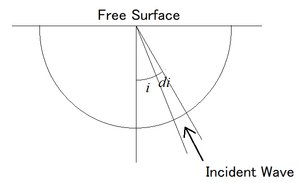Plane waves incident on a free surface from an arbitrary direction (Nagasaka and Nozu, 2022)
Major Research Development of strong motion estimation method for near-fault strong ground motions
One of the important factors that determine the characteristics of strong seismic motions is site amplification characteristics. The site amplification characteristics can spatially vary significantly, even within the same port & harbor. For the zoning of site amplification characteristics, the horizontal-to-vertical Fourier spectral ratio of constant-microtremor(constant-microtremor H/V spectrum) is used. While this constantmicrotremor H/V spectrum is an essential tool for practical purposes, there is still a debate on how it can be interpreted in terms of elastodynamics. Although some scientists have argued that the spectrum indicates the particle trajectories of Rayleigh waves, a highly plausible new theory has recently been proposed that claims that the spectral ratio of the reflected waves that occur when horizontal and vertical impulse excitations are applied at the ground surface represents the constantmicrotremor H/V spectrum (Sanchez-Sesma et al., 2011). To prove the veracity of this theory, a wide range of preconditions must be satisfied, one of which is that the energy ratio of the S-to-P waves transmitted through the bedrock must be 2(α/β)3. As for our FY 2021 activity related to this theory, we conducted theoretical reviews to determine whether the aforementioned precondition could be met and also published parts of our research findings in a scientific journal in English (Nagasaka and Nozu, 2022). According to our study, when S-waves and P-waves are isotropically incident on a free surface leading to repeated reflections, the energy ratio of the S-to-P waves might increasingly approach 2(α/β)3 regardless of the initial conditions.




